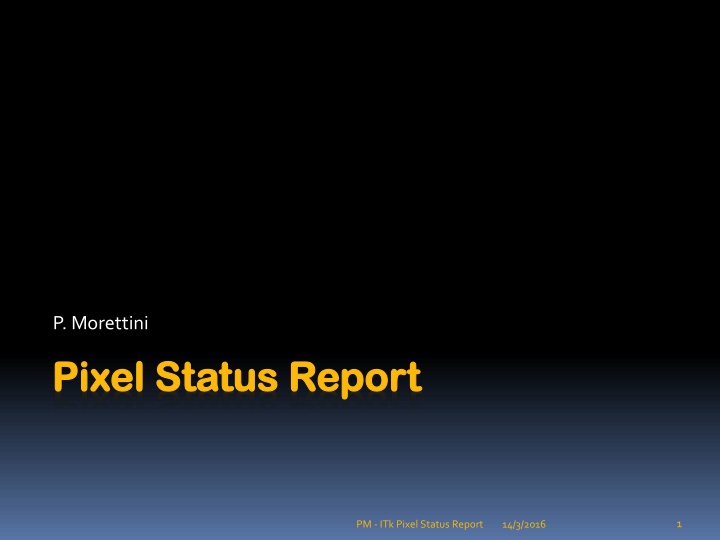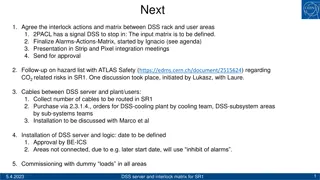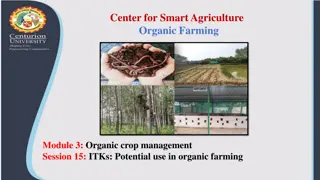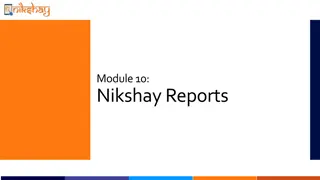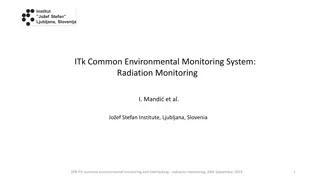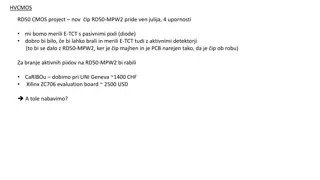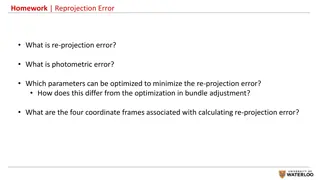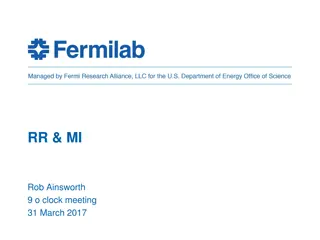Summary of ITk Pixel Status Reports and Organization Updates
The content provides updates from ITk Pixel Status Reports on project transitions, decision-making processes, organizational structure, and key focus areas. It also outlines responsibilities, strategic planning, and critical items to address within the project timeline. The Planning section outlines activities planned for 2016-2019 related to Strip TDR, Pixel TDR, production models, and technological strategies. The content emphasizes the importance of collaboration, decision-making, and aligning strategies to achieve project goals efficiently.
Download Presentation

Please find below an Image/Link to download the presentation.
The content on the website is provided AS IS for your information and personal use only. It may not be sold, licensed, or shared on other websites without obtaining consent from the author.If you encounter any issues during the download, it is possible that the publisher has removed the file from their server.
You are allowed to download the files provided on this website for personal or commercial use, subject to the condition that they are used lawfully. All files are the property of their respective owners.
The content on the website is provided AS IS for your information and personal use only. It may not be sold, licensed, or shared on other websites without obtaining consent from the author.
E N D
Presentation Transcript
P. Morettini Pixel Pixel Status Status Report Report 1 PM - ITk Pixel Status Report 14/3/2016
Dove siamo? Siamo in una fase di transizione tra un progetto di R&D ed un progetto di costruzionedi un rivelatore molto complicato. Credo sia naturale che, specialmente in alcune aree critiche, si continui a lavorare con una mentalit aperta a nuovi sviluppi potenzialmente promettenti. Ma il tempo comincia a diventare un fattore critico, ed alcune decisioni importanti dovranno essere prese nei prossimi mesi. Dobbiamo quindi cominciare a pensare in un ottica un po meno locale e un po pi orientata al raggiungimento del risultato globale. Utilizzer le slides presentate alla fine dell ultima ITk week per illustrare le decisioni critiche che giattendono nei prossimi mesi. 14/3/2016 2 PM - ITk Pixel Status Report
Pixel Organization 2016 Pixel PL : P. Morettini Deputy PL : P. Grenier Closed sessions Drive R&D efforts Handle dependencies and conflicts between groups Manage documentation Define milestones, review dates Define strategies to select among multiple options Take decisions and propose them to ITk SC for approval. Open sessions Promote exchange of ideas between experts in different fields Stimulate discussions and convergence to common solutions when needed Gather information from experts, collect and track the documentation, distribute it to the collaboration. Steering committee / Design Group PL, DeputyPL D. Giugni : PE R. Bates, D. Dobos, T. Flick, F. Huegging, J. Grosse-Knetter C. Gemme : LTF M. Garcia-Sciveres : RD53 contact D. Ferrere : Pixel PL Mechanics and Integration D. Dobos D. Giugni Detector Electronics T. Flick Read-out system and Software J. Grosse-Knetter Modules R. Bates F. Huegging Sensors S. Grinstein A. Macchiolo CMOS N. Wermes 3 14/3/2016 PM - ITk Pixel Status Report
Items to attack now Project schedule / Project organization / Cost calculation / Production model Preliminary plan needed for the Strip TDR; important input will soon arrive from the institute aspiration survey. Global support and integration Pixel/Strips interface and connections to local supports must be defined for the Strips TDR. Local support design definition In parallel with the LTF, assess the feasibility of the proposed solution. Fix the design by the Pixel TDR. FE chip requirements / link with RD53 Strong correlation between RD53 and ITk schedule. Clarify the share or responsibilities. Sensors strategy Progressively reduce the number of technical options; prepare market survey in 2018 CMOS strategy Need to define how to proceed at the end of 2016. Pixel TDR must contain a detailed plan. BB strategy A critical item for the production. A solid plan is mandatory in the Pixel TDR Conceptual design of the powering schema and of the data transmission tree A lot of dependencies everywhere in the project. Needed for simulation, layout definition, global mechanics, TDAQ Effort in progress to define a baseline cables numerology (LTF Step 1.5, Cable Task Force). 14/3/2016 4 PM - ITk Pixel Status Report
Planning 2016-2019 2016 2017 2018 2019 Strip TDR Pixel TDR Pixel MOU Pre-production Costand Schedule review Requirementsreview Layout definition Local support conceptualdesign Testswith prototypes Global support conceptual design RD53-A tests RD53 final design CMOS demonstratortests CMOS phase II CMOS review Bump-bondingvendors qualification / sensormarket survey Module PRRs 5 PM - ITk Pixel Status Report 14/3/2016
Local support design definition The LTF, and ITk in general, will provide a layout recommendation by the end of 2016, with particular (but not exclusive) focus on detector performance. In parallel, the Pixel Mechanics group will analyze prototypes of the proposed local support solutions, to verify the compliance with specifications. By the end of the year we should have a well defined metrics to select the best design of the Pixel local supports. In 2017 the design must be optimized and reviewed, based on the analysis of full scale prototypes. Pixel TDR must contain a single solution, endorsed by the collaboration and validated by a complete set of qualification measurements. 14/3/2016 6 PM - ITk Pixel Status Report
Qualification and test plan by Q4 2016 A testing plan has been drafted out and circulated so far. It covers the full design qualification process. However, by Q4 2016, only some of the test will be performed Test of the nominal TFM Each local support design with at least three silicon heaters (or three different cooling blocks) are tested on the thermal setup in SR1. The scope is to verify the as build thermal performance. A direct comparison of the various types of local support will be, therefore, possible Robustness test The same few samples (tested as above) should go through a test meant to evaluate how much the operational conditions might affect the thermal performance. In more details: - Thermal cycling (100 cycles spanning the OTR) - Pressure (100 cycles over MDP. TFM is measured again to exclude or evaluate degradation. Note that radiation effects are not part of the test for now. Production thermal performance variation (TFM variance along and within samples). Estimated only on previous samples. It should be that only 0.15% of the heaters loaded on samples show a TFM larger than 1.5 times the design value - 14/3/2016 PM - ITk Pixel Status Report 7
Qualification and test plan by Q4 16 (2) Mechanics validation By now we do not know the layout. Stave lengths will keep changing. It is unpractical to produce a full-size prototype and measure the mechanical performances on a variety of load cases (including humidity, temperature change) However, some critical performances need to be verified. The idea here is to qualify the FEA model on real prototypes on which the deformation is measured applying: - Dummy loads (central weights) - Thermal load (uniform temperature drop) And then, FEA is tuned to meet the measured values. Specs compliance is then verified with a simulation of the full stave combining the loads case accordingly to the ATU-SYS-ES-0029 Note that the effect from humidity variation is not considered at this stage. 14/3/2016 PM - ITk Pixel Status Report 8
By the Pixels TDR (Q4 2017) As for the local supports what must be done by Q4 2017 is rather clear. In practice, the chosen design prototype needs to be qualified for what has been left over: Humidity variation Irradiation Full size prototype Unfortunately this qualifies the mechanics only. However, we must have by then a complete stave/ring with services and modules. I do need more time to address this and more inputs from the collaboration. 14/3/2016 PM - ITk Pixel Status Report 9
TFM measurements in SR1 10 14/3/2016 PM - ITk Pixel Status Report
TFM measurement on an I-Beam sample 11 14/3/2016 PM - ITk Pixel Status Report
Modules La tabella di marcia viene determinate dal chip di RD53: il prototipo RD53-A verr sottomesso a fine anno, e rappresenter una milestone importante. Sfortunatamente entrer solo marginalmente nel TDR. Se tutto andr bene, il chip finale per ATLAS potrebbe essere disponibile all inizio del 2019. Le relazioni con RD53 vanno migliorate. Per i sensori, il TDR dovrebbe chiarire la baseline per ogni strato del rivelatore, con un numero limitato di opzioni. Costi, yield e rate di produzione vanno chiariti, e il numero di varianti ridotto al minimo. La gara di appalto potrebbe essere svolta nel 2018. La scelta del tipo di sensore ha implicazioni profonde anche sul design del sistema di raffreddamento e sui supporti. Il bumpbonding rimane un item critico, anche se alcuni risultati incoraggianti arrivano da diversi produttori. 14/3/2016 12 PM - ITk Pixel Status Report
Planar sensors / QUAD modules 14/3/2016 13 PM - ITk Pixel Status Report
3D sensors 14 14/3/2016 PM - ITk Pixel Status Report
Passive CMOS sensors Passive CMOS sensors 15 14/3/2016 PM - ITk Pixel Status Report
First RD53 prototype under test 16 14/3/2016 PM - ITk Pixel Status Report
Example of H-reflow SnAg Bump Bonding at HPK on quad modules 17 14/3/2016 PM - ITk Pixel Status Report
BB tests at Selex on a 2x2 cm2, 50x50 m test chip 18 14/3/2016 PM - ITk Pixel Status Report
Module production schedule 2016 2017 2018 2020 2019 Strip TDR Pixel MOU Pixel TDR RD53A submission RD53A irrad and tests BB for RD53A test and validation RD53A modules RD53A modules irrad and test Sensor tender Bump bonding tender RD53B design RD53B irrad and test Pre-production CHIP PRR Chip production PRR Sens Sensor production PRR BB PRR Mod 19 14/3/2016 PM - ITk Pixel Status Report
In-Pixel efficiency contribution per BC Fastest from the center of the pixel. contribution coming Bias Voltage 80 V CMOS: Interesting results from the old submissions / Timing 20 14/3/2016 PM - ITK PIXEL STATUS REPORT
First CMOS demonstrators already available to test 21 14/3/2016 PM - ITk Pixel Status Report
CMOS strategy I risultati ottenuti finora sono incoraggianti. Diversi dimostratori di grandi dimensioni sono in fase di produzione o in test. C un interesse ed una fiducia crescenti nella possibilit di realizzare un chip monolitico. DI fatto, sembra la sola soluzione veramente interessante per coprire una grande superficie: una soluzione con sensore attivo ed accoppiamento capacitivo sembra essere non molto pi economica di un sensore CMOS passivo con bump-bonding tradizionale, ma notevolmente pi rischiosa. D altro canto la strada per dimostrare la fattibilit di un rivelatore monolitico che possa funzionare sul quinto layer ancora molto lunga. La sola strategia possibile con una qualche chance di successo quella di fare uno sforzo di design unico a livello ITk. La fonderia potrebbe essere LFundry (che permette di fare stiching). Ci sono discussioni in corso ma ancora nulla di concreto. Un gruppo di disegno comune potrebbe per partire nei prossimi mesi, e credo che, come INFN, dovremmo contribuire. 14/3/2016 22 PM - ITk Pixel Status Report
Data Link workshop Abbiamo fatto un mini-workshop per discutere le strategie per la trasmissione dati. Un tipico esempio di problema che coinvolge tutti gli aspetti del rivelatore (meccanica, simulazione, moduli, FE, readout). Potrebbero servire 22 K links a 5 Gb/s per un layout come quelli di step 1.5 14/3/2016 23 PM - ITk Pixel Status Report
Read out Se forse presto per parlare del sistema di redoutfinale, dovremmo cominciare subito a progettare il sistema di test per la produzione, che dovr essere qualificato nel 2019. Abbiamo 6-7 diverse schede di lettura, il rischio di frammentazione del lavoro molto alto, mentre sarebbe bene avere un singolo setup di test. Inoltre la situazione del read-out al pozzo molto delicata, e io credo che una qualche forma di sinergia Pixel-ITk sul DAQ sia essenziale per mantenere il rivelatore attuale in funzione fino al 2023. I gruppi italiani possono contribuire alla realizzazione di un sistema comune di test in laboratorio, che funzioni con tutte le schede di acquisizione e tutti I tipi di moduli. 14/3/2016 24 PM - ITk Pixel Status Report
